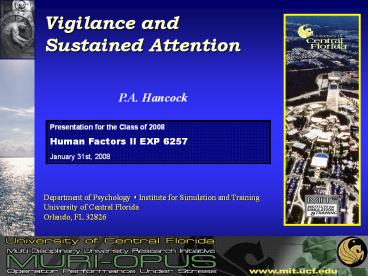Vigilance - PowerPoint PPT Presentation
1 / 30
Title:
Vigilance
Description:
Mackworth was the founder of modern vigilance research, a term he took from the ... Hedonic Tone. Confidence & Control. Pre- and Post-Vigil Scores for the DSSQ Scales ... – PowerPoint PPT presentation
Number of Views:2327
Avg rating:3.0/5.0
Title: Vigilance
1
Vigilance and Sustained Attention
P.A. Hancock
Presentation for the Class of 2008 Human Factors
II EXP 6257 January 31st, 2008
Department of Psychology s Institute for
Simulation and Training University of Central
Florida Orlando, FL 32826
2
Mackworth was the founder of modern vigilance
research, a term he took from the neurologist,
Sir Henry Head. His original experimental
research was triggered by WW II concerns for
radar operators looking for submarines out over
the Bay of Biscay. His original monograph on the
topic, republished in Sinakos text, still
represents the best introduction to the area.
Mackworth was the first to formally identified
the vigilance decrement function which remains
pertinent to all operations in automated and
semi-automated systems today. His work on stress
effects was also pivotal. He worked at the APU
Cambridge for part of his career, as did many
other influential scientists who have had a
fundamental impact on applied human performance
theory. Others include Broadbent, Poulton,
Baddeley, Wilkinson, etc.
Norman Mackworth
3
The Vigilance Decrement
4
Theories of Vigilance
Inhibition theory (behaviorism) Expectancy
Theory Arousal Theory Resource Theory
5
Raja Parasuraman
Raja Parasuraman has long-standing research
programs in two areas, human factors and
cognitive neuroscience. The first concerns human
performance in human-machine systems,
particularly with respect to the influence of
automation and computer technology on attention,
memory, and vigilance. His second area of
research is the cognitive neuroscience of
attention, where he has conducted studies using
information-processing paradigms, event-related
brain potentials and functional brain imaging
(PET, fMRI), both in normal populations and in
relation to aging and Alzheimers disease. He
also has a research thrust in the molecular
genetics of cognition, specifically attention and
working memory. Finally, he has recently combined
his interests in human factors (ergonomics) and
cognitive neuroscience by developing the field of
neuroergonomics, which he defines as the study of
brain and behavior at work.
6
The Vigilance Taxonomy
Task Type Simultaneous vs. Successive Modality
Visual vs. Auditory Source Complexity Single
vs. Multiple Event Rate Slow vs. Fast
7
(No Transcript)
8
Psychophysics of Vigilance
First Order Factors Immediate physical
properties of the stimulus Modality Signal
Salience (Conspicuity) Event Rate Second Order
Factors Characteristics of the stimulus inferred
by the observer based on experience with the
task Signal Uncertainty (Spatial Temporal)
9
Psychophysics of Vigilance Modality
10
Psychophysics of Vigilance Event Rate
11
Psychophysics of Vigilance Signal Salience
12
Psychophysics of Vigilance Signal Duration
13
Overall Workload as a Function of Periods of Watch
14
Weighted Frustration as a Function of Periods of
Watch
15
Workload and Performance
Note. A Auditory Task V Visual Task SIM
Simultaneous Task SUC Successive Task T x C
interaction between task type and display
complexity
16
Workload and Performance
17
Task-Based Stress and Performance
Note. A Auditory Task V Visual Task SIM
Simultaneous Task SUC Successive Task T x C
interaction between task type and display
complexity
18
Task-Based Stress and Performance
19
DSSQ
Task Engagement Energetic Arousal Motivation Conce
ntration
Worry Self-focused Attention Self-Esteem Task-rela
ted Cognitive Interference Task-irrelevant
Cognitive Interference
20
Pre- and Post-Vigil Scores for the DSSQ Scales
21
(No Transcript)
22
Configural Displays and Vigilance
23
Configural Displays and Vigilance
24
Configural Displays and Vigilance
25
Sensitivity as a function of periods of Watch for
the integration task
1
0.98
0.96
0.94
0.92
A'
0.9
conint
0.88
nonint
objinit
0.86
0.84
0.82
0.8
1
2
3
4
Periods of Watch (6-min)
26
Sensitivity as a function of periods of Watch for
the focused attention task
1
0.98
0.96
0.94
0.92
A'
0.9
conf
nonf
0.88
objf
0.86
0.84
0.82
0.8
1
2
3
4
Periods of Watch (6-min)
27
Response Bias as a function of periods of Watch
for the integration task
1
0.9
0.8
0.7
0.6
Response Bias
0.5
conint
0.4
nonint
objinit
0.3
0.2
0.1
0
1
2
3
4
Periods of Watch (6-min)
28
Response Bias as a function of periods of Watch
for the focused attention task
1
0.9
0.8
0.7
0.6
conf
Response Bias
0.5
nonf
objf
0.4
0.3
0.2
0.1
0
1
2
3
4
Periods of Watch (6-min)
29
Overall Workload as a Function of Display Type
30
(No Transcript)

